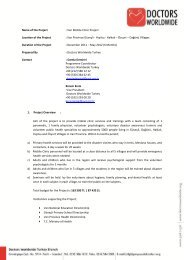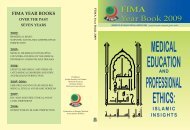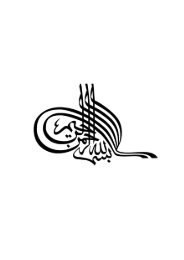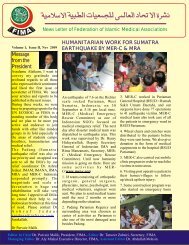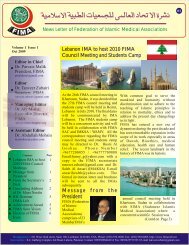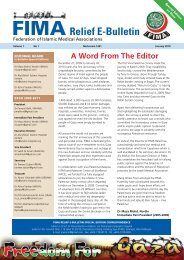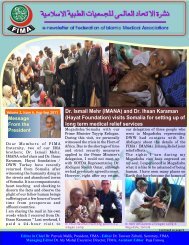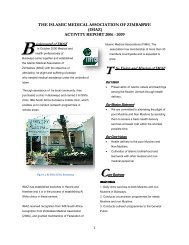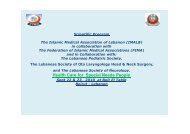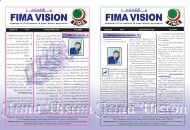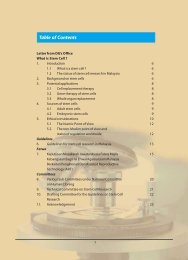FIMA Year Book 2010-2011 - Federation of Islamic Medical ...
FIMA Year Book 2010-2011 - Federation of Islamic Medical ...
FIMA Year Book 2010-2011 - Federation of Islamic Medical ...
Create successful ePaper yourself
Turn your PDF publications into a flip-book with our unique Google optimized e-Paper software.
<strong>FIMA</strong> GLOBAL RELIEF<br />
government’s care near the main cities <strong>of</strong> al-<br />
Fashir, Niala and al-Jinaina.<br />
First <strong>FIMA</strong> <strong>Medical</strong> Relief Missions:<br />
Led by then <strong>FIMA</strong> president, Dr. Aly Misha’l, in<br />
collaboration with the Sudan-<strong>Islamic</strong> <strong>Medical</strong><br />
Association (SIMA) and the Sudan Health<br />
Ministry, four specialists from The <strong>Islamic</strong><br />
Hospital in Jordan, and workers from SIMA went<br />
by plane from Khartoum to al-Fashir city, capital<br />
<strong>of</strong> Northern Darfur. The trip took 2 hours.<br />
Immediately the group delivered medical supplies<br />
to the main hospital, which was clearly in need for<br />
all kinds <strong>of</strong> supplies. The group started medical<br />
work, together with their Darfur counterparts.<br />
They visited the main refugee camp at Abu-Shoke,<br />
20 km. from Al-Fashir, where 42 thousand<br />
refugees reside in homes made <strong>of</strong> hay and wood,<br />
fed and protected by the government, and cared<br />
for medically by Sudanese, and Red Cross<br />
personnel.<br />
First <strong>FIMA</strong> relief team to Darfur-Abu Shoke IDPs Camp,<br />
October 2004<br />
<strong>Medical</strong> workers from Arab <strong>Medical</strong> Union<br />
(AMU)-Egypt were the first to come for relief,<br />
followed by Saudi Red Crescent, then <strong>FIMA</strong>,<br />
<strong>Islamic</strong> Hospital-Jordan and Hayat-DWW-Turkey.<br />
The main medical problems encountered were:<br />
Malaria, gastroenteritis, hepatitis and children<br />
malnutrition. During the whole stay, the team<br />
learned about only 6 injured people who stated<br />
they were attacked in the desert by armed men<br />
who could be outlaws or opponents <strong>of</strong> the<br />
government. It took them two days to be brought<br />
to the government hospital in al-Fashir.<br />
<strong>FIMA</strong> team visited the refugee camp and was<br />
again informed that the main health problems<br />
were malaria, gastroenteritis and children<br />
malnutrition.<br />
The Red Cross hospital was empty during the time<br />
<strong>of</strong> the visit. 70 thousand refugees were assisted to<br />
leave the camp back to their villages, with<br />
government support and protection.<br />
The team also visited the medical school at al-<br />
Fashir University. They informed the team that<br />
their doctors conduct health services to the<br />
refugees whenever they obtain medical supplies.<br />
They welcomed Arab and Muslim medical teams<br />
to come and conduct mutual medical work to<br />
needy refugees and villagers.<br />
The team received warm welcome by Darfur<br />
government, health authorities, intellectuals and<br />
the local community at large.<br />
The needs for more medical teams and supplies<br />
were very clear and pr<strong>of</strong>ound.<br />
A second <strong>FIMA</strong> team, again came from Jordan<br />
<strong>Islamic</strong> Hospital in December, 2004, with<br />
participation <strong>of</strong> 5 specialists, mainly surgeons.<br />
Most surgeries, <strong>FIMA</strong> team dealt with, were<br />
elective or long standing. Very few violencerelated<br />
casualties were encountered and dealt with<br />
by Sudanese surgeons.<br />
Other teams from IMA S. Africa and other IMAs<br />
arrived successively.<br />
The most requested supplies were:<br />
Antibiotics, antimalarials, I.V. fluids (with<br />
infusion sets, canulas and syringes), baby food,<br />
oral electrolytes and vitamins. Water purification<br />
systems, and insecticides were also needed.<br />
<strong>Medical</strong> personnel mostly needed were:<br />
Ophthalmologists, pediatricians, internists,<br />
surgeons and anesthesiologists.<br />
<strong>FIMA</strong> <strong>Year</strong><strong>Book</strong> <strong>2010</strong>-<strong>2011</strong> 22




